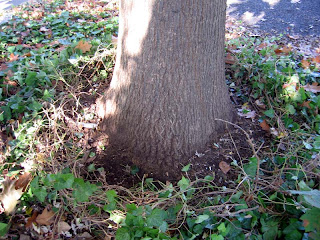
A typical scene along a property line, where English Ivy has taken over. Say you tire of its imperialistic ambitions and static green, but don't want to engage in a down and dirty tug of war (see previous post, 3/5/07). If it happens to be fall, and leaves are plentiful, it's a perfect time to do it in without hardly a pull.

Enter that most versatile of substances, cardboard, easily requisitioned along curbsides. The bigger the pieces, the better. Some people use newspapers, but many layers are needed, they decompose too fast, and their small size makes for many more cracks where the ivy could push up. Tools needed are shown.
The principal behind this approach involves the need of plants for energy. Cut off sunlight for months at a time, and even a powerful-looking patch of ivy will fade back into the ground. With a constant need to metabolize, and no new energy coming in, the ivy roots die of starvation.
Use this approach only if there are no spring bulbs or other desired plants mixed in with the ivy.

Begin by pulling the ivy away from trees and shrubs. If it's rained recently and the ground is soft, most stems pull easily out of the ground. Cut the stubborn ones with hand clippers. Also work along the edges of the patch, pulling the ivy back to reduce the area that needs to be covered.

Then spread the cardboard, overlapping 6" to a foot to prevent any ivy from pushing up through gaps. Where there are lots of shrubs to work around, and different sizes of cardboard to work with, it starts to feel like a jigsaw puzzle, finding the right piece to fit any particular spot. In these photos, the process is simplified because the shrubs are all in a line.

Be sure to cover all the ivy, or sever connections between the areas covered and those that will remain exposed. Otherwise, the ivy that doesn't get covered will continue sending energy to the ivy under the cardboard.

Now it's time to cover the whole thing up with leaves, giving the impression that there is no ivy or cardboard. Over, say, two to six months, the ivy will give up the ghost, the cardboard will decompose and the area can be planted with wildflowers, bulbs, what have you. In the meantime, the leaves provide a quiet, woodsy feel. This whole project took about two hours.
 A few shrubs blooming around town right now:
A few shrubs blooming around town right now: Here's a closeup.
Here's a closeup.














































